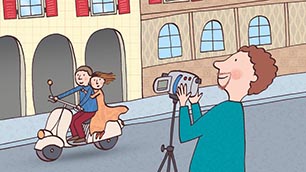| Silvia: | Let's continue our lezione di grammatica italiana by exploring the verbo stare. Let me conjugate it for you. | io | sto | | tu | stai | | lui/lei/Lei | sta | | noi | stiamo | | voi | state | | loro | stanno | |
| Connor: | Is this an irregular verbo, Silvia? |
| Silvia: | Sì. The verbo stare in italiano replaces the verbo essere quite often. As a general rule, we can say that the verbo essere means to be and the verbo stare means to stay. However, when used in idiomatic expressions and specific constructions, the verb stare changes its meaning. Let me give you some examples. If I were to ask you: how are you? How would you answer my question in English? |
| Connor: | I'm good! |
| Silvia: | OK. You used the verb to be in English. In italiano you would have to use the verb stare. |
| Connor: | Io sto bene. |
| Silvia: | Esattamente. The same rule applies when you ask somebody how are you in italiano. You say: come stai? |
| Connor: | Come stai, Silvia? |
| Silvia: | Sto male, which means I am not feeling well. |
| Connor: | Really? |
| Silvia: | No, no, sto bene, that was just an example! Come stanno your grandparents, Connor? |
| Connor: | Loro stanno molto bene! |
| Silvia: | This is good, Connor! So, today we learned that in idiomatic expressions about one's health and greetings, the Italian language uses the verbo stare. |
| Connor: | Come stiamo? |
| Silvia: | Stiamo meglio, grazie. |
| Connor: | Stiamo meglio... got it! |
| Silvia: | Connor, I’m sure you remember that in our first lesson we mentioned the difference between "tu" and "Lei". |
| Connor: | Sì! I’m supposed to use "Lei", the formal version of "tu", whenever I’m talking to somebody who is older than me. |
| Silvia: | Molto bene. In italiano, we follow the same rule when greeting a person. You will say "Come stai?" to someone your age, a family member, or somebody you’ve known for a long time. However, you will use "Come sta?", employing the third person of the verbo stare, when greeting someone who’s older than you, somebody you either don't know very well or are meeting for the first time, as well as when greeting somebody in a position of authority, such as a professor or a politician. |
| Connor: | So what should I say when I meet my family for the first time in Italia? |
| Silvia: | If you’re meeting someone who’s part of your close famiglia, you may say "Come stai?" even if they’re older than you. |
| Connor: | So… what should I say to my zio Peppino? |
| Silvia: | Chi è zio Peppino? |
| Connor: | Zio Peppino è the brother of my mamma Giovanna! |
| Silvia: | Well, even if you haven’t met him yet, you can absolutely greet him with "ciao, come stai, zio Peppino?". Lui è close famiglia. |
| Connor: | And what about the other family members whom I don't know yet? |
| Silvia: | Use your judgement. Anyway, if you’re talking to somebody older than you, always use "Lei". You will probably notice something that might seem strange to you at first, but is very common in Italia, which is you using the formal "Lei" while greeting and talking to someone and them replying by using the informal version "tu". Don't assume that you can switch to the informal "tu" just because they did. If they want to be addressed with "tu", dare del tu in italiano, they will let you know. Till then, keep using "Lei". They will think you are very gentile... |
| Connor: | Gentile... polite.. io sono molto gentile, sì! |





















